|
| |
Important Penwork Tea Chest with Depictions of the Silk
Road Circa 1820
Please click on images to enlarge or |
slide show |thumbnail index |
Reference: TC600
Description:
TC600: A very fine penwork tea chest, of elongated
octagonal form, the penwork depicting
scenes from the Silk Road. Inside there are two lift out tea
canisters and a cut glass Irish sugar bowl.
This is a truly stunning artwork. Although at first sight it appears
to comply with the conventions of floral and Chinoiserie decoration, the
arrangement and execution show the workings of a truly original mind.
In
such work the larger panels are usually reserved for the main narrative
scene, with the frieze decorated with floral or symmetrical designs.
Here, the main body is painted with robust flora and the frieze is
painted with figures in landscapes. The scale being long and narrow
suggests a long road and implies a journey through the countries of the
East: "The Silk Road".
Origin: UK; Circa 1820: Materials:
Maple, mahogany, glass.
Size: It measures 12.1 inches
wide by 6.2 inches deep and it is 6.4 inches high
including feet: 30.8 cm wide by 15.7 cm deep by 16.2 cm high.
Condition: good
overall, working lock and key, see images.
There is a question about one of the lift out canisters. The penwork is exquisite!.
As each person has different criteria and antiques by their very nature
have wear please enlarge the images and ask for extra information
as needed.
|

The floral decoration draws on a multiplicity of traditions.
The
composition is symmetrically arranged and it features acanthus leaves
making reference to neoclassicism. There is however a richness and
exuberance in the flowers bursts through the restraints of neoclassicism.
The details and sumptuousness of the flowers are reminiscent of 16th
century European embroideries. The centre is punctuated by a shell,
suggesting both nature and classicism.
A classical looking vessel
holds another shell which forms the escutcheon. This is not symmetrical,
with a hint at rococo. It is a witty and whimsical way to mark the
centre of the panel and create a keyhole.
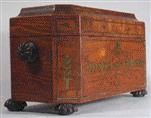


|


|
The Tea Chest open to reveal two canisters and sugar bowl.
|

Going around the frieze: Starting from
front, /stage right. How do you describe these objects: Building
Chinese roof exaggerated curves. Flying bird. Man hat
wearing
with stick . Who dresses like this? The man is leading a loaded
horse/camel. He is followed by a loaded man, yoke balanced. The benefit
was the neck massage. These were
important things being carried. I would love to see someone dressed like
this at a party. This building has a thatched roof. It is at the
side of a widened river. On the other side of the river a larger
building with a tiled roof. The flora/plant-life in the foreground is proportioned
for visual effect rather than the actuality. An elephant tusks afore, collared
, man on head, harnessed to carry a shaped object, with
precarious man following u . Elephant looks complicit:;
agriculture, gentle, basked flowers, man seeding with buildings in
background. Kneeling in work, being tender to plants. Oriental buildings
in background
. Man on horse, sword in hand,... to be
continued below....
Please click on images to enlarge or |
slide show |thumbnail index | Request
current list of available tea
caddies.

Going around the frieze: On the corner a man on
horse wearing
three-cornered hat,
sword in hand, horse on two legs, the man looking heroic,
three-cornered hat. , Chinese roofs; a man wearing an oriental hat sits
aloft a camel. The saddle seems to be decorated to look like a shield. Others
are gathered on the road, which meets a river bank; one seems to be waving. A
dog is running at the river edge. There is a boat out on the river. Another
group approach. An outrider on horseback is followed by two others
sitting in a covered wagon. On the corner there is an archer
with full quiver on horseback. The short side shows a traveler crossing a hump
back bridge with oriental buildings in the background. On the corner a man
leads an elephant.
Please click on images to enlarge
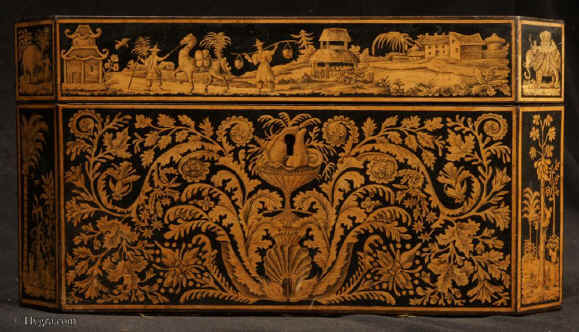
This is a truly stunning artwork. Although at first sight it appears
to comply with the conventions of floral and chinoiserie decoration, the
arrangement and execution show the workings of a truly original mind. In
such work the larger panels are usually reserved for the main narrative
scene, with the frieze decorated with floral or symmetrical designs.
Here, the main body is painted with robust flora and the frieze is
painted with figures in landscapes. The scale being long and narrow
suggests a long road and implies a journey through the countries of the
East.
The floral decoration draws on a multiplicity of traditions. The
composition is symmetrically arranged and it features acanthus leaves
making reference to neoclassicism. There is however a richness and
exuberance in the flowers bursts through the restraints of neoclassicim.
The details and sumptuousness of the flowers are reminiscent of 16th
century European embroideries. The centre is punctuated by a shell,
suggesting both nature and classicism. A classical looking vessel
holds another shell which forms the escutcheon. This is not symmetrical,
with a hint at rococo. It is a witty and whimsical way to mark the
centre of the panel and create a keyhole.
|
.
|
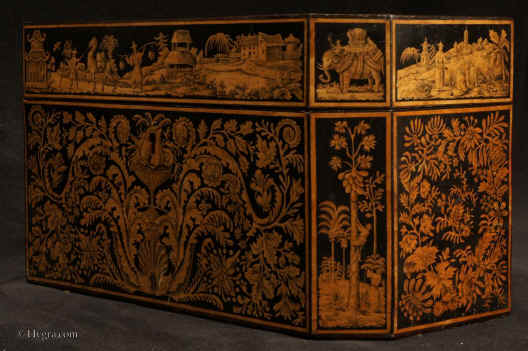
|
The large floral and small man and beasts theme continues around the
box.
|
Please click on images to enlarge or |
slide show |thumbnail index | Request
current list of available tea
caddies.

|
End view. A composition of stylized robust flowers arranged in a wreath
with a flower in the center.
Some of the flowers make an attempt at neoclassical designs such as
anthemions (honeysuckle).
|
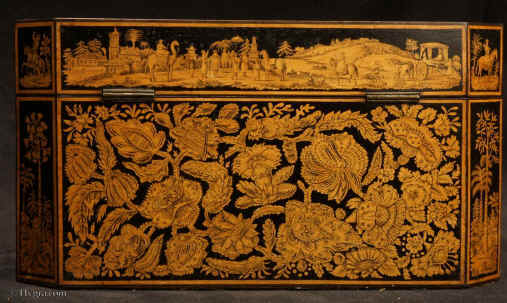
|
The back of the Tea Chest. The flowers on this panel are not
symmetrically arranged and the details on them like the dots, diamond
patterns and lines, are much more in the tradition of embroidery
design.
|
Please click on images to enlarge or |
slide show |thumbnail index | Request
current list of available tea
caddies.
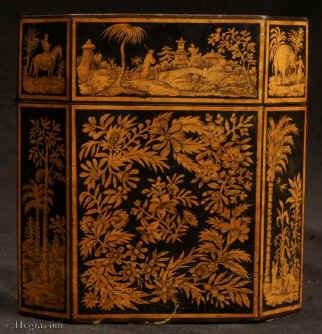
|
The end view. Here the flowers appear to be more like English flowers,
perhaps wild. The artist explored different flower painting in
virtuosity.
|
Please click on images to enlarge or |
slide show |thumbnail index | Request
current list of available tea
caddies.

|
The top reverses the form of the front by having the main picture in
the centre, framed by a garland of flowers. These flowers are painted in
a precise controlled way, but still retain a delicacy which implies a
naturalness and delicacy.
|
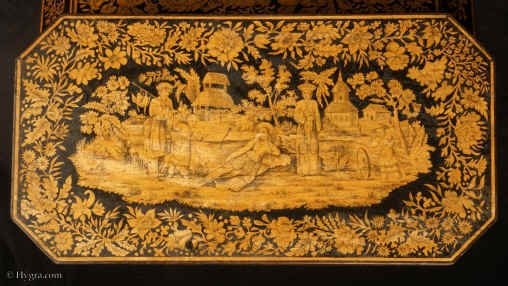
|
The top picture is rooted in the chinoiserie tradition with figures
in a landscape with small pavilions and flowers which make no
concessions to perspective. Although there are signs of wear, the
picture has not lost any of its whimsical
charm. I have seen other versions of this theme
depicted on another box.
See: Hygra: A Regency Penwork Three Compartment Tea Caddy circa 1820.
|
Please click on images to enlarge
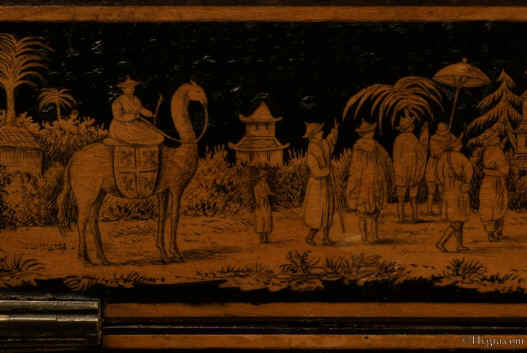
|
Detail of scene with oriental figures. It appears to be a
meeting/parting. The man is sitting in peculiar fashion on a peculiar
horse who appears to have the neck and face of a camel. The horse must
be an attempt at illustrating reports of the strange breeds of the East.
There is a design on the cloth hanging from the saddle which could be a
coat of arms, a design for rank, or some other distinguished mark.
The scene suggests traveling on an open road with a forward
movement.
|
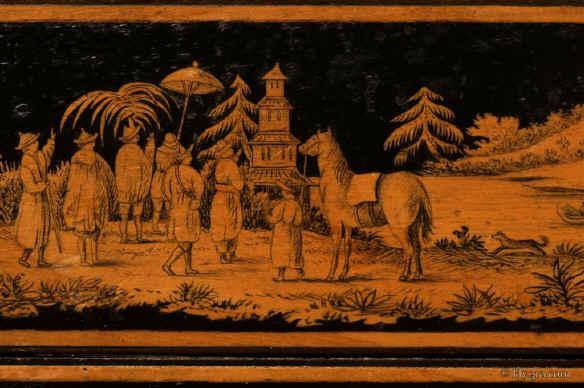
|
One of the figures lifts his hand perhaps in farewell
greeting.
A river runs to the right.
Water was a very important element in the reports of the early
travelers. A small boat adds interest in this busy scene and a small dog
adds an extra note of interest and movement.s
|
Please click on images to enlarge or |
slide show |thumbnail index | Request
current list of available tea
caddies.
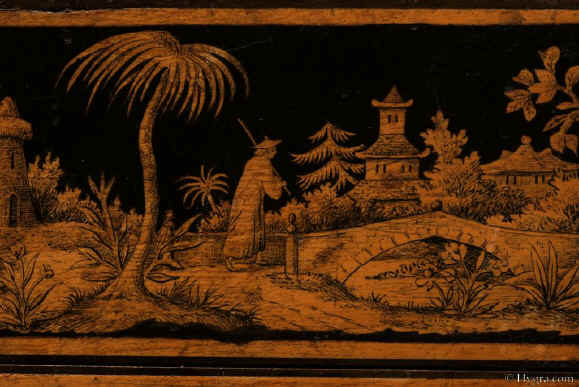
|
A small bridge with a figure ready to cross. Buildings in the
background. In typical chinoiserie fashion there is no rhyme or
reason as to size. The palm tree undulates alarmingly, the flowers
are gigantic compared to the tiny buildings which are not so
far.
|
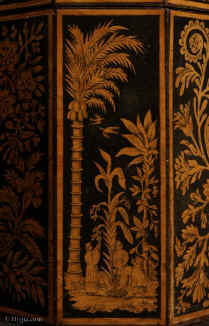
|
Figures pointing to the fruit high up. The leaves on some of the plants
are as large as the people, in keeping with reports of strange, huge
plant life.
|
Please click on images to enlarge or |
slide show |thumbnail index | Request
current list of available tea
caddies.

|
Reaching for the coconuts/papayas? on a strange looking hybrid plant
straight out of someone's fertile imagination encouraged by often
exaggerated reports of exotic trees. Another person ready to catch.
|
Please click on images to enlarge
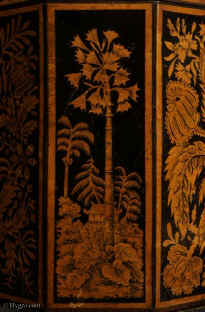
|
Another tree with what looks like a bamboo trunk and huge ginkgo
leaves, perhaps the result of a report of wild ginkgo growing in China.
The leaves on the ground are huge suggesting orgiastic jungle
growth.
|
Please click on images to enlarge or |
slide show |thumbnail index | Request
current list of available tea
caddies.
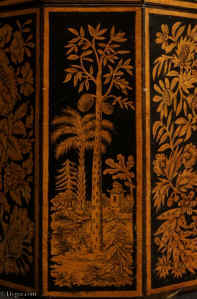
|
More exotic fruit, durian/bread fruit? on a sparsely leafed tree.
All these vignettes are delicately drawn, each one drawing attention
to different details of oriental life as perceived in the early 19th
century by people who informed themselves by third party reports and
artwork.
|
Please click on images to enlarge
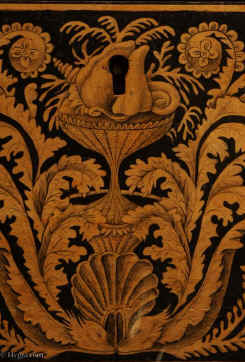
|
Detail of the escutcheon showing the original and whimsical way the
keyhole has been created. The acanthus leaves look as if they
are metamorphosing dolphins, a neoclassical motif employed here with
great subtlety and artistry.
|
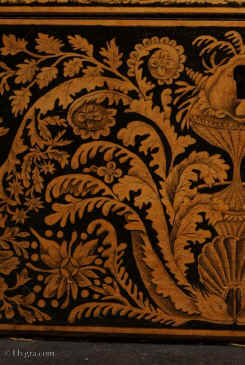
|
Detail showing the sureness of hand. The leaves and flowers are drawn
and shaded with precision and sensitivity. The confident undulations of
the acanthus leaves, the curves and fine lines of other flora are
evidence of true artistry.
|
Please click on images to enlarge or |
slide show |thumbnail index |
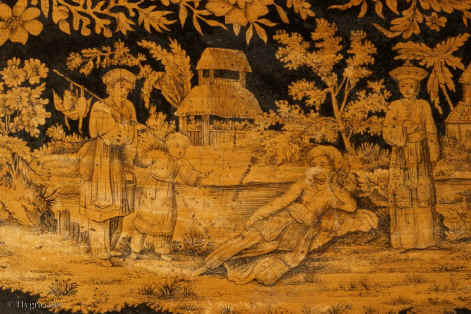
|
Bringing game to the reclining figure.
|
Please click on images to enlarge or |
slide show |thumbnail index |
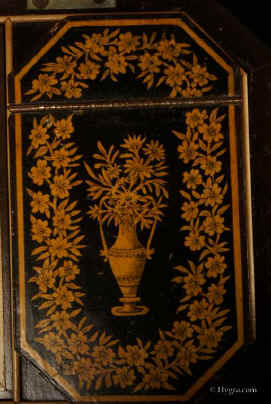
|
The lids are decorated with Grecian urns and delicate-wild?- flowers
in a mixture of neoclassicism and naturalism.
|
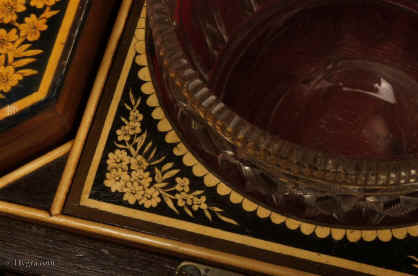
|
The bowl in place, set in the surround decorated with forget-me-nots.
|
Please click on images to enlarge
|
slide show |
thumbnail index |Request
current list of available tea
caddies.
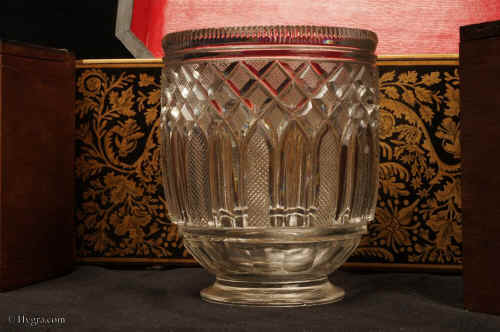
|
The crystal bowl is of exceptional quality. It is deeply cut and
very heavy. Many of the bowls were manufactured in Ireland.
|

|
The underside of the canisters.
|
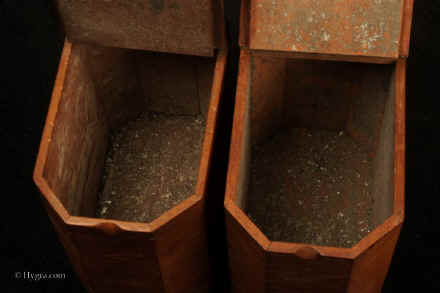
|
The interior of the canisters showing remnants of the original foil. The
inside of the two canisters looks identical.
|
Please click on images to enlarge or |
slide show |thumbnail index |Request
current list of available tea
caddies.
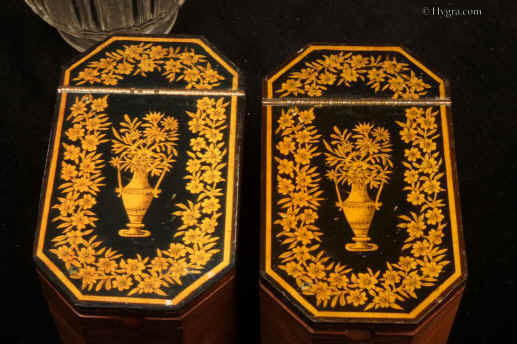
|
There is a question here:
I have documentary evidence that one of these lids is a
reproduction of the other, it came with the chest.
and from the pictures it is obvious.
No one but the utterly slavish would copy losses in the one reproductively
on the other.
|

A card inside the caddy implies that one of the canisters is reproduction
of the other, and Anne Isaac is responsible, or takes credit. is the
provenance itself not genuine!
"Painted by Miss Ann Isaac"
|
|
Please click on images to enlarge
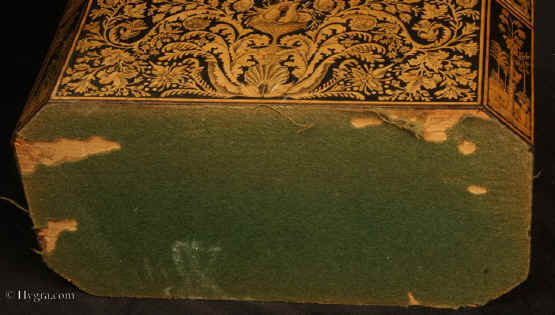
|
The underside showing original cloth cover.
|
Please click on images to enlarge or |
slide show |thumbnail index | Request
current list of available tea
caddies.

|
This escutcheon is wonderful in its whimsy.
A classical looking vessel
holds another shell which forms the escutcheon. This is not symmetrical,
with a hint at rococo.
It is a witty and whimsical way to mark the
centre of the panel and create a keyhole.
|
Please click on images to enlarge or |
slide show |thumbnail index | Request
current list of available tea
caddies.
All text and images and linked images are ©
1999-2013 Antigone Clarke and Joseph O'Kelly. If you require any further
information on permitted use, or a licence to republish any material, email us
at copyright@hygra.com
|
